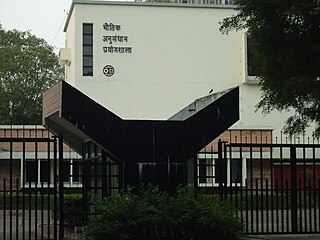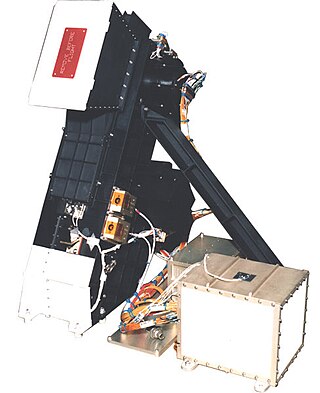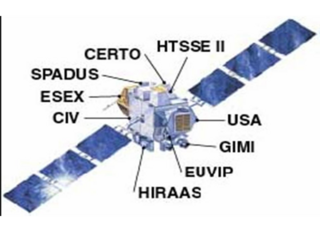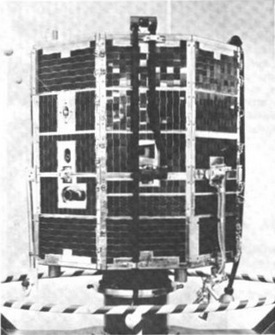Related Research Articles

The Laboratory for Atmospheric and Space Physics (LASP) is a research organization at the University of Colorado Boulder. LASP is a research institute with over one hundred research scientists ranging in fields from solar influences, to Earth's and other planetary atmospherics processes, space weather, space plasma and dusty plasma physics. LASP has advanced technical capabilities specializing in designing, building, and operating spacecraft and spacecraft instruments.

The thermosphere is the layer in the Earth's atmosphere directly above the mesosphere and below the exosphere. Within this layer of the atmosphere, ultraviolet radiation causes photoionization/photodissociation of molecules, creating ions; the thermosphere thus constitutes the larger part of the ionosphere. Taking its name from the Greek θερμός meaning heat, the thermosphere begins at about 80 km (50 mi) above sea level. At these high altitudes, the residual atmospheric gases sort into strata according to molecular mass. Thermospheric temperatures increase with altitude due to absorption of highly energetic solar radiation. Temperatures are highly dependent on solar activity, and can rise to 2,000 °C (3,630 °F) or more. Radiation causes the atmospheric particles in this layer to become electrically charged, enabling radio waves to be refracted and thus be received beyond the horizon. In the exosphere, beginning at about 600 km (375 mi) above sea level, the atmosphere turns into space, although, by the judging criteria set for the definition of the Kármán line (100 km), most of the thermosphere is part of space. The border between the thermosphere and exosphere is known as the thermopause.

Space weather is a branch of space physics and aeronomy, or heliophysics, concerned with the time varying conditions within the Solar System, including the solar wind, emphasizing the space surrounding the Earth, including conditions in the magnetosphere, ionosphere, thermosphere, and exosphere. Space weather is distinct from, but conceptually related to, the terrestrial weather of the atmosphere of Earth. The term "space weather" was first used in the 1950s and came into common usage in the 1990s. Later, it was generalized to a "space climate" research discipline, which focuses on general behaviors of longer and larger-scale variabilities and effects.

Cascade, Smallsat and Ionospheric Polar Explorer (CASSIOPE), is a Canadian Space Agency (CSA) multi-mission satellite operated by the University of Calgary. The mission development and operations from launch to February 2018 was funded through CSA and the Technology Partnerships Canada program. In February, 2018 CASSIOPE became part of the European Space Agency's Swarm constellation through the Third Party Mission Program, known as Swarm Echo, or Swarm-E. It was launched September 29, 2013, on the first flight of the SpaceX Falcon 9 v1.1 launch vehicle. CASSIOPE is the first Canadian hybrid satellite to carry a dual mission in the fields of telecommunications and scientific research. The main objectives are to gather information to better understand the science of space weather, while verifying high-speed communications concepts through the use of advanced space technologies.

The TIMED mission is dedicated to study the influences energetics and dynamics of the Sun and humans on the least explored and understood region of Earth's atmosphere – the Mesosphere and Lower Thermosphere / Ionosphere (MLTI). The mission was launched from Vandenberg Air Force Base in California on 7 December 2001 aboard a Delta II rocket launch vehicle. The project is sponsored and managed by NASA, while the spacecraft was designed and assembled by the Applied Physics Laboratory at Johns Hopkins University. The mission has been extended several times, and has now collected data over an entire solar cycle, which helps in its goal to differentiate the Sun's effects on the atmosphere from other effects. It shared its Delta II launch vehicle with the Jason-1 oceanography mission.

Aeronomy is the scientific study of the upper atmosphere of the Earth and corresponding regions of the atmospheres of other planets. It is a branch of both atmospheric chemistry and atmospheric physics. Scientists specializing in aeronomy, known as aeronomers, study the motions and chemical composition and properties of the Earth's upper atmosphere and regions of the atmospheres of other planets that correspond to it, as well as the interaction between upper atmospheres and the space environment. In atmospheric regions aeronomers study, chemical dissociation and ionization are important phenomena.

The Physical Research Laboratory is a National Research Institute for space and allied sciences, supported mainly by Department of Space, Government of India. This research laboratory has ongoing research programmes in astronomy and astrophysics, atmospheric sciences and aeronomy, planetary and geosciences, Earth sciences, Solar System studies and theoretical physics. It also manages the Udaipur Solar Observatory and Mount Abu InfraRed Observatory. The PRL is located in Ahmedabad.

The Special Sensor Ultraviolet Limb Imager (SSULI) is an imaging spectrometer that is used to observe the earth's ionosphere and thermosphere. These sensors provide vertical intensity profiles of airglow emissions in the extreme ultraviolet and far ultraviolet spectral range of 800 to 1700 Angstrom and scan from 75 km to 750 km tangent altitude. The data from these sensors will be used to infer altitude profiles of ion, electron and neutral density.
Dynamics Explorer was a NASA mission, launched on 3 August 1981, and terminated on 28 February 1991. It consisted of two unmanned satellites, DE-1 and DE-2, whose purpose was to investigate the interactions between plasmas in the magnetosphere and those in the ionosphere. The two satellites were launched together into polar coplanar orbits, which allowed them to simultaneously observe the upper and lower parts of the atmosphere.

The Advanced Research and Global Observation Satellite (ARGOS) was launched on 23 February 1999 carrying nine payloads for research and development missions by nine separate researchers. The mission terminated on 31 July 2003.

Explorer 54, also called as AE-D, was a NASA scientific satellite belonging to series Atmosphere Explorer, being launched on 6 October 1975 from Vandenberg Air Force Base board a Thor-Delta 2910 launch vehicle.
Satya Prakash is an Indian plasma physicist and a former senior professor at the Physical Research Laboratory. He is known for his studies on Langmuir probes and other contributions in space and plasma sciences. A protégé of Vikram Sarabhai, Satya Prakash is an elected fellow of all the three major Indian science academies such as Indian Academy of Sciences, Indian National Science Academy and National Academy of Sciences, India as well as the Gujarat Science Academy and is a recipient of the Hari Om Ashram Prerit Senior Scientist Award. The Government of India honored him with Padma Shri, the fourth highest Indian civilian award for his contributions to the discipline of Physics, in 1982.

Rohini is a series of sounding rockets developed by the Indian Space Research Organisation (ISRO) for meteorological and atmospheric study. These sounding rockets are capable of carrying payloads of 2 to 200 kilograms between altitudes of 100 to 500 kilometres. The ISRO currently uses RH-200, RH-300, RH-300 Mk-II, RH-560 Mk-II and RH-560 Mk-III rockets, which are launched from the Thumba Equatorial Rocket Launching Station (TERLS) in Thumba and the Satish Dhawan Space Center in Sriharikota. The first Rohini rocket was launched in 1967. A later series of ISRO satellites was also named Rohini.
Ionospheric Connection Explorer (ICON) is a satellite designed to investigate changes in the ionosphere of Earth, the dynamic region high in our atmosphere where terrestrial weather from below meets space weather from above. ICON studies the interaction between Earth's weather systems and space weather driven by the Sun, and how this interaction drives turbulence in the upper atmosphere. It is hoped that a better understanding of this dynamic will mitigate its effects on communications, GPS signals, and technology in general. It is part of NASA's Explorer program and is operated by University of California, Berkeley's Space Sciences Laboratory.

Global-scale Observations of the Limb and Disk (GOLD) is a heliophysics Mission of Opportunity (MOU) for NASA's Explorers program. Led by Richard Eastes at the Laboratory for Atmospheric and Space Physics, which is located at the University of Colorado Boulder, GOLD's mission is to image the boundary between Earth and space in order to answer questions about the effects of solar and atmospheric variability of Earth's space weather. GOLD was one of 11 proposals selected, of the 42 submitted, for further study in September 2011. On 12 April 2013, NASA announced that GOLD, along with the Ionospheric Connection Explorer (ICON), had been selected for flight in 2017. GOLD, along with its commercial host satellite SES-14, launched on 25 January 2018.
ExoCube (CP-10) is a space weather satellite developed by the California Polytechnic State University – San Luis Obispo and sponsored by the National Science Foundation. It is one of many miniaturized satellites that adhere to the CubeSat standard. ExoCube's primary mission is to measure the density of hydrogen, oxygen, helium, and nitrogen in the Earth's exosphere. It is characterizing [O], [H], [He], [N2], [O+], [H+], [He+], [NO+], as well as the total ion density above ground stations, incoherent scatter radar (ISR) stations, and periodically throughout the entire orbit. It was launched aboard a Delta II rocket with the NASA SMAP primary payload from Vandenberg AFB in California on January 31, 2015.

Student Nitric Oxide Explorer, was a NASA small scientific satellite which studied the concentration of nitric oxide in the thermosphere. It was launched in 1998 as part of NASA's Explorer program. The satellite was the first of three missions developed within the Student Explorer Demonstration Initiative (STEDI) program funded by the NASA and managed by the Universities Space Research Association (USRA). STEDI was a pilot program to demonstrate that high-quality space science can be carried out with small, low-cost free-flying satellites on a time scale of two years from go-ahead to launch. The satellite was developed by the University of Colorado Boulder's Laboratory for Atmospheric and Space Physics (LASP) and had met its goals by the time its mission ended with reentry in December 2003.
The Lunar Polar Exploration Mission (LUPEX) or Chandrayaan-4 is a planned joint lunar mission by the Indian Space Research Organisation (ISRO) and Japan Aerospace Exploration Agency (JAXA). The mission would send an uncrewed lunar lander and rover to explore the south pole region of the Moon no earlier than 2025. JAXA is likely to provide the under-development H3 launch vehicle, while ISRO would be providing the lander and the rover.

Orbiting Vehicle 3-2, launched 28 October 1966, was the fourth satellite to be launched in the OV3 series of the United States Air Force's Orbiting Vehicle program. The satellite measured charged particles in orbit, mapping irregularities in the ionosphere, particularly the auroral zone. OV3-2 reentered the Earth's atmosphere on 29 September 1971.

Dynamics Explorer 2 was a NASA low-altitude mission, launched on 3 August 1981. It consisted of two satellites, DE-1 and DE-2, whose purpose was to investigate the interactions between plasmas in the magnetosphere and those in the ionosphere. The two satellites were launched together into polar coplanar orbits, which allowed them to simultaneously observe the upper and lower parts of the atmosphere.
References
- ↑ "Department of Space, Annual Report 2019-2020" (PDF). Archived from the original (PDF) on 7 October 2021.
There are proposals for two small satellites with high and low inclination named 'Disturbed and quiet time Ionosphere-thermosphere System at High Altitudes (DISHA)' which aims to study the effects in the Ionosphere-Thermosphere system during space weather events and normal condition of the Sun. The proposed DISHA mission will yield critical information on the structures in plasma and neutrals that adversely affect communication and navigation during space weather events. This will eventually help in a better description of influence of space weather on space based technological systems and sub-systems.
- ↑ "Space Applications Centre: 'Aeronomy satellite in advanced planning stage'". The Times of India. October 23, 2018. Retrieved 2022-01-27.
- ↑ "Instruments onboard Chandrayaan-3 undergoing tests, readying for launch later this year: Former ISRO chief". The Indian Express. 2022-01-27. Retrieved 2022-01-27.
- 1 2 ISRO Exploration Mission - Space Radiation Workshop-2022 Day 3 (Video). ARIES Nainital. 2022-01-26. Event occurs at 45 minutes 36 seconds.
- 1 2 3 4 5 6 7 8 Pallamraju, Duggirala (2022-05-10). DISHA H & L: ISRO's Proposed Twin Aeronomy Satellite mission (Video). Event occurs at 1 hour 05 minutes 22 seconds.
- ↑ Jatiya, Satyanarayan (18 July 2019). "Rajya Sabha Unstarred Question No. 2955" (PDF). Retrieved 30 April 2023.
Disturbed and quite-type Ionosphere System at High Altitude (DISHA) satellites are planned during 2024-25
- ↑ "OU receives slice of £1m Government funding to enhance space technology". OU News. 2021-03-19. Retrieved 2022-01-27.
- ↑ "Space Physics Laboratory Annual Report 2019-20" (PDF). Retrieved 27 January 2022.

